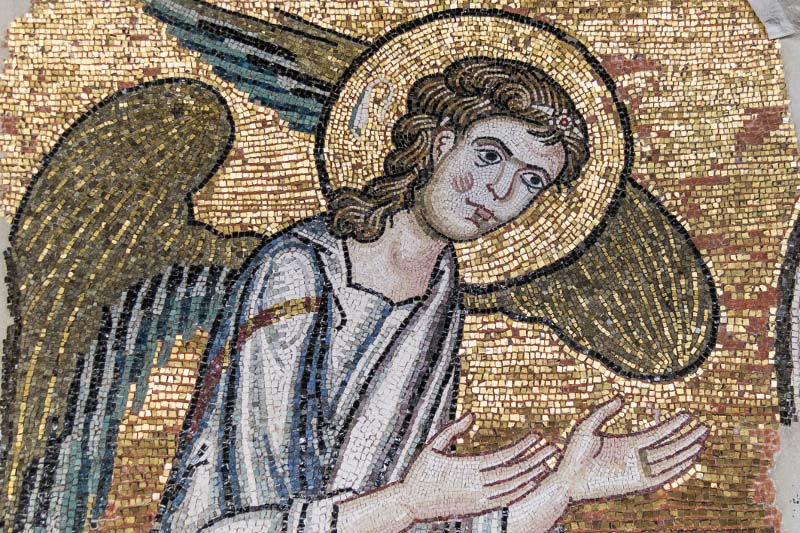By Anne-Marie O’Connor. BETHLEHEM, WEST BANKSilvia Starinieri, a young restoration technician, was slowly passing a thermographic camera over the smooth plaster walls of the Church of the Nativity, the traditional birthplace of Jesus Christ, when she spotted an intriguing shape.
As she and her colleagues began painstakingly scraping away the plaster, a radiant face emerged, illuminated by mother-of-pearl. When the team saw the first golden tiles of a shimmering halo, “it was a very emotional moment,” says Starinieri, 28.
Beneath the plaster stood an eight-foot-tall angel, lost for centuries but now rediscovered and reunited with six other angels that watch over pilgrims in one of the oldest churches in Christendom.
First Glimmer
As restorers began removing plaster, a small section of mosaic tile hinted at the lost angel that was covered for centuries, possibly to protect it from deterioration.
PHOTOGRAPH BY PIACENTI
The seventh angel was an unexpected reward of an arduous, multi-year effort to rescue the 1,700-year-old basilica from centuries of neglect. The lack of maintenance left the church’s priceless mosaics obscured under layers of dust and soot or destroyed by rain water that seeped in from the leaky roof. Yet the surviving mosaics have emerged with such luster that it’s difficult to believe they were created nearly 1,000 years ago.
“For this opera, we needed our finest hands,” says Giammarco Piacenti, the CEO of the Tuscany-based Piacenti restoration company. Those skilled hands are uncovering new insights into the artisan who is believed to have created the mosaics, and about their relationship to sacred art at other places of worship in the Holy Land.
An urgent rescue
The mosaic restoration is part of the first known overhaul of the revered church since 1479, and it came just in the nick of time. A Palestinian official warned in 2011 that churchgoers faced a dangerous “risk of collapsing beams,” and the United Nations declared the church an endangered World Heritage site in 2012.
Palestinian Authority President Mahmoud Abbas pressured church patriarchs to set aside their differences and usher in the team of world-renowned Italian restorers in 2013. Soon they were working round-the-clock shifts.
Commissioned in the 12th century by the Crusader king Almaric I and Byzantine emperor Manuel Comnenus, the mosaics were made with tiles of glass, mother-of-pearl, and local stones, with gold and silver leaf-pressed under clear glass. The tiles were tilted to maximize their impact on pilgrims peering up from below.
The mosaics portray Jesus and his human forebears, including Joseph and a dolorous Mother Mary. The 12 apostles are depicted, including “doubting Thomas” with Jesus pulling his hand to his crucifixion wound. There are glimmering saints and patriarchs, even a baby camel.
Read the complete article on misho.co


